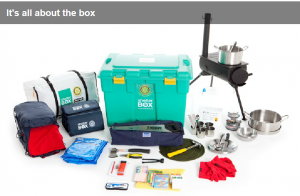Over the past weekend we attended a Rotary International conference in Phoenix, Arizona. (Joe belongs to the “eclub” that’s centered there. It has members around the world who meet weekly online.) As always, Rotary impresses and inspires us with its programs, and ShelterBox was a highlight for us this time.
ShelterBox has been on the news a fair amount over the past few years; I remember Anderson Cooper in Haiti telling the audience how ShelterBox tents were being delivered after that terrible earthquake. And I read in the news just last week that ShelterBox was sending a response team into Moore, Oklahoma, to assess needs there.
It’s all in the name: ShelterBox.
What does ShelterBox do? Since 2000, the organization has provided emergency supplies such as tents, stoves, blankets and water filtration systems to help families rebuild their lives after losing their homes and possessions following a natural disaster or political conflict. Haiti was just one of their deployments; according to their website, they are currently at work in Jordan, Myanmar, and the Solomon Islands.
What’s in the box?
After all our recent focus on survival kits, it was interesting to see just what goes into a ShelterBox. The Box is meant to provide relief for an extended period, and for an extended family. The dome tent is modeled after a typical African bush hut, with built-in mosquito screens, groundsheets, ventilation and internal privacy screens so people can divide the space as they see fit. Thermal blankets, insulated ground sheets, treated mosquito nets and water purification equipment provide protection against contaminated water supplies.
The box contains a stove, pans, utensils; tools include a hammer, ax, saw, hoe, rope, pliers and wire cutters. There is also a children’s pack with books, crayons and pens. The volunteer at the Rotary conference told me that when a community is wiped out, setting up a school becomes a top priority, and these simple items can help get that started.
So what does this have to do with us?
- Action Item: Check out the ShelterBox website and see what they’re doing. Read stories of survivors who’ve been served by this organization. It’s inspiring.
- Action Item: Compare your list of long-term “survival supplies” with what goes into the ShelterBox. You may get an idea or two.
- Action Item: Consider donating or volunteering.
You can learn more at www.shelterboxusa.org.
(P.S., just so you know, ShelterBox USA is a 501(c)(3) nonprofit organization headquartered in Sarasota, Florida.)
Don't miss a single Advisory.
Thank you for subscribing.
Something went wrong.

